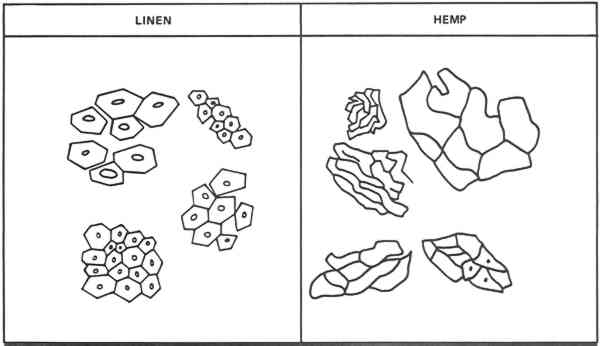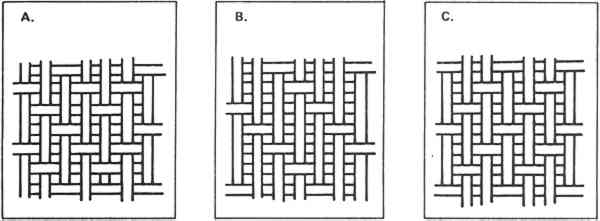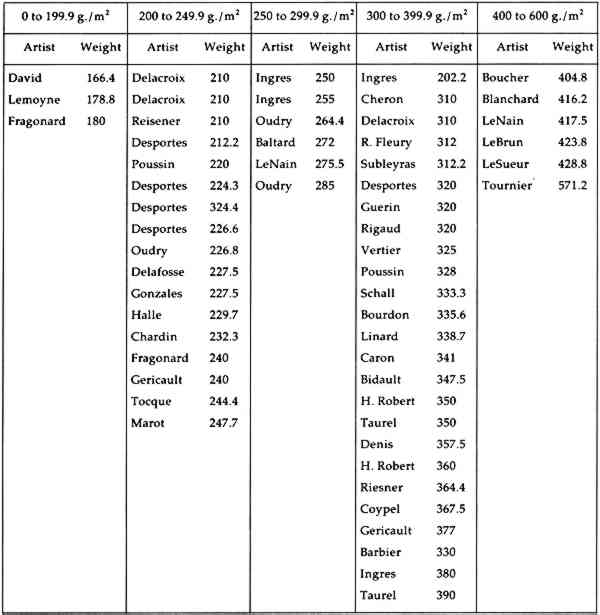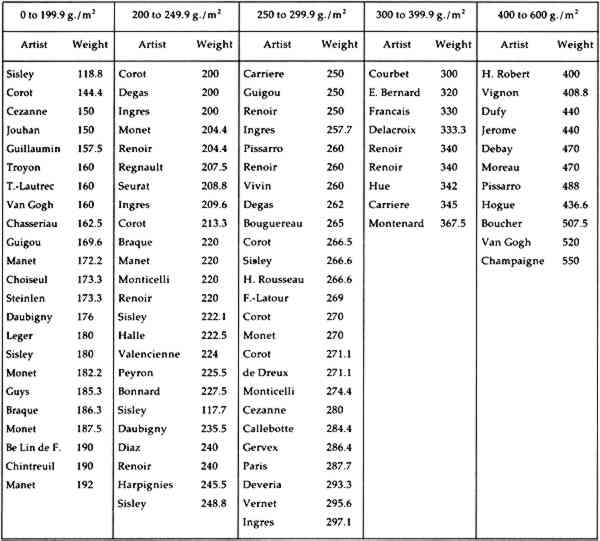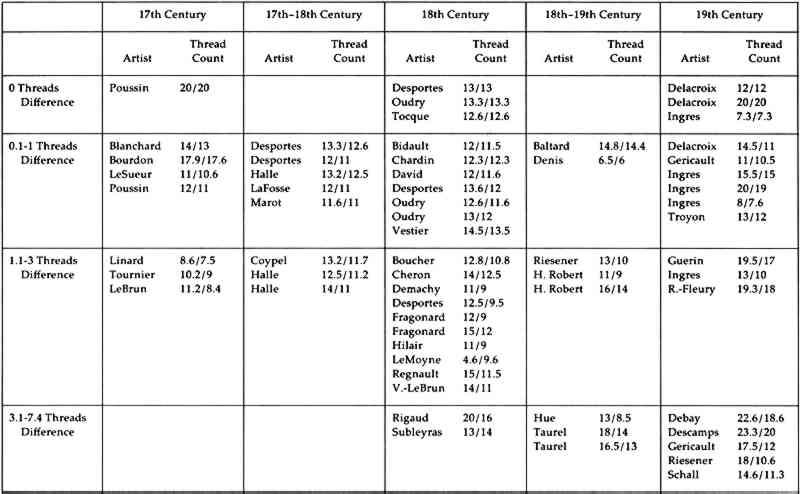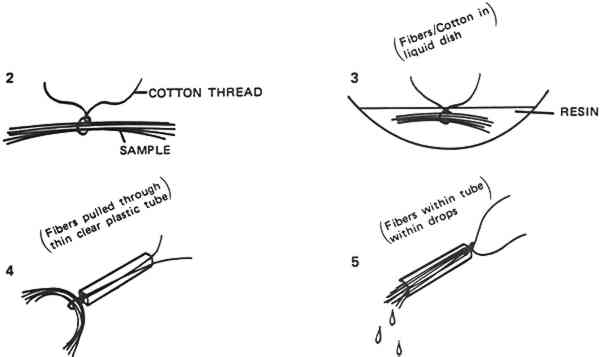A STUDY OF FRENCH PAINTING CANVASESKatrina VANDERLIP CARBONNEL
ABSTRACT—A large number of canvas samples from paintings by 116 French artists are analyzed for fiber type and weight. Results are categorized chronologically as well as by artist, and it may be seen that prior to the end of the 18th century, hemp canvases were most common, with linen supplanting hemp by the beginning of the 19th century and cottonlinen blends and cotton making their appearance by the end of the 19th century. The method of fiber analysis is described in an appendix. 1 INTRODUCTION1.1 SELECTING THE SAMPLESTHE COLLECTION OF SAMPLES used in this study is actually composed of canvas fragments selected from two different sources (see list). In both cases, the cloth samples from the original support of authenticated paintings were chosen to be identified and analyzed. The samples were made up of an eclectic group of canvases from Dutch, English, French, Italian and Spanish paintings. The largest category by far was the French. The first is a group of fabric samples including both lining and original painting canvases gathered since the 1950s by the Service de la Restauration des Peintures des Mus�es Nationaux (France). I studied all of those samples that could be traced back to an authentic painting. However, the number of non-French samples did not prove large enough to give an adequate idea of the individual country's use of painting canvases. The non-French samples were, therefore, put aside until other canvas fragments can be studied and added to them to form a body for analysis at least the size of the collection used in this article, which is made of canvases from paintings by 116 different French artists. The second set of samples I put together from fragments given to me by private painting restorers working in Paris. 1.2 ORIGINS OF THE SAMPLESTHE COLLECTION CAN ALSO be divided into three categories according to the method by which the samples were drawn:
Part I of this study will briefly describe the method of preparing the samples and how they were identified. Part II will deal with the physical characteristics of the samples studied: fiber type, weave pattern, the weight of the fabrics per square meter, and the thread count. Part III will attempt to describe in general terms the types of canvases used by French artists in the 17th, 18th and 19th centuries, showing that hemp canvases were the most common type of canvas used up to the first quarter of the 19th century, at which time linen fabrics took the lead, and that the disappearance of the use of hemp canvases coincides exactly with the decline in the production of hemp in France which began ca. 1820. Part IV will describe my conclusions. 2 PART I2.1 PREPARING THE SAMPLES2.1.1 CUTTING A SQUARETHE FIRST STEP in preparing the samples for study was to cut a square piece of canvas from the fragment of cloth removed from the painting. When possible, the squares were 10 cm � 10 cm, which was the case only when dealing with the transferred canvases. The square samples cut from tacking margins were sometimes only 1 cm � 1 cm. The samples are made square to facilitate multiplying their surface area to obtain their weight per square meter. Also, the square gives the same accuracy in counting the threads per centimeter in both the directions of the warp and of the weft; for example, threads counted along 10 cm, then divided by 10 give a more accurate count per centimeter than just counting the threads along one centimeter. 2.1.2 CLEANINGTHE NEXT STEP in preparing the samples was to remove the remaining dirt, ground, and paint layers. The sample was soaked in water to swell the fibers and to loosen the particles of ground and paint caught in the interstices of the cloth. The particles were then delicately mechanically removed with a scalpel. 2.1.3 RAVELING THE EDGESTHE SQUARES HAD been cut slightly larger than the intended size of the sample. The edges were then raveled off until the sample was the desired size. The raveling was done after the sample was cleaned so that, should a thread ravel off during the cleaning process, it would not affect the final size of the sample. The samples assumed to be hemp or linen were raveled off while wet as these two fibers are stronger when wet, while the samples assumed to be cotton were unraveled when dry. The stronger the thread being raveled off, the easier it was to remove it. The reason the sample was fringed in this way was to facilitate counting the threads; it is 2.1.4 WEIGHINGTHE FRINGE WAS cut off the sample just before it was weighed. The weight of the sample was multiplied in order to obtain the weight per square meter of the canvas. 3 PART II3.1 FABRIC CHARACTERISTICS3.1.1 FIBER TYPESTHE THREE FIBER types found in this study of French painting canvases are hemp, linen or flax, and cotton, which were used through the centuries in that order. Figures 1, 2 and 3 show this transition from the use of hemp to the use of linen and finally to the use of cotton. Cotton is easily recognized because it looks like a twisted ribbon under the microscope, unlike hemp and linen which look like bamboo.
Linen and hemp have often been confused as the two fibers can only be properly identified by examining their cross-section under the microscope. All the samples studied were identified using the method described by M. C. Gay and R. Monrocq in “Identification des Fibres Textiles Naturelles par Examen Microscopique,” Annales du Laboratoire de Recherche des Mus�es de France, 1972, p. 16–22 (see Fig. 4 and the Appendix). The change over from the use of hemp painting canvases to the use primarily of linen fabrics was probably effected without the artists of that period really realizing it themselves.
When the production of hemp fell in the early 19th century, that of linen took over for the fabrics that had been hemp. There are two grades of linen, a fine one used for voiles, laces, and delicate linens and a less noble grade made into cleaning rags, dish towels, sacks, and canvases. The coarser linen fibers look and feel just like hemp fibers when spun and woven into cloth. Hemp can even be refined and bleached whitish, to resemble high-quality linen; but this takes painstaking efforts, and hemp is most often found in its coarser state. Finely woven linen canvases such as those associated with the impressionists are found well after the switch from hemp to linen had taken place. During the transition period in the early 19th century, the artists' canvases are either coarse-grade linen or hemp, two similar fabrics. French artists did not adopt cotton canvases as readily as they had linen ones. But even at the beginning of the 19th century, the Industrial Revolution and the large production of cotton in the United States started to erode away the popularity of linen, more time consuming and costly to produce. French painters had traditionally painted on strong and durable fabrics—hemp and linen, and the transition from hemp to linen painting canvases had occurred smoothly; and artists were aware that cotton fabrics were not as well adapted as hemp and linen ones to use as supports for paintings. Cotton is weaker than the two other fibers and much weaker when wet; it will also not resist bacterial growth as well. Only starting at the turn of this century did painters begin to paint on cotton canvases, because linen fabrics had by then become much more expensive. Even today, artists who are concerned with the durability of their works still favor linen over cotton when it is available and affordable. Figure 1 shows that among the samples studied, no cotton canvases were found before the end of the 19th century. 3.1.2 WEAVESDIFFERENT CANVAS weaves can vary the aspect of paintings as the fabric support projects its surface texture on the ground and paint layers. Most fabric supports are tabby weave, which creates the most regular painting surface. However, rep weave, twill weave, and satin weave canvases can be found as well (see Fig. 5). Figure 5b illustrates a typical rep weave cloth, an example of which is Hogue's “Le Dernier Survivant” of 1936 (14.6 single/11 double threads per cm, 496 g per square meter).
One seldom used rep weave consists of doubled warp and weft threads (see Fig. 5a). Fantin Latour chose such a canvas for his “L'Atelier des Batignolles” of 1870 (1/11.5 double threads per cm, 260 g per square meter). Twill weave canvases are usually associated with the Italian School, as seen in the fabric used by Romanelli for “Moise Sauv� des Eaux” (23/10.6 threads per cm) in the 16th century, and with the English School in the 18th–19th century; but they are present in French paintings as well. In the 19th century, French artists used a variety of twill weave patterns. Cezanne painted “Nature Morte � la Soupi�re” in 1883 on twill canvas (21.5/20 threads per cm) (see Fig. 6a). Delacroix and Guigou used another twill fabric design, Delacroix for “Turc Assis sur un Divan” (30/29 threads per cm) and Guigou for “Paysage de Provence” and “La Route de la Genestre” (32/32 threads per cm) (see Fig. 4c). Francais chose a twill weave canvas for “Orph�e” 1863 (14/12 threads per cm) (see Fig. 6b).
The more interesting twill weave canvases are the striped blue and white mattress cloths. There are three such samples identified among the French canvas Satin weave canvases are probably actually damasked linen table cloths (see Fig. 5d). These were the cloths available when the painters needed them, and it was possibly less expensive to paint on a spotted old table cloth than to buy a new canvas for the same purpose. Ingres used a fine satin weave fabric for “Roger et Angelique” (18.5/17 threads per cm) and Regnault did the same for “Education d'Achille” (22/19 threads per cm). 3.1.3 WEIGHTNOT ALL THE SAMPLES could be weighed as some were too small to give an accurate weight in grams per square meter. It was not always possible to completely remove the grime and ground incrusted in the canvas without damaging the fibers; therefore, the weight is not always precise. The heaviest samples are mostly linen, as are the lighter samples; the hemp samples are in the middle range (see Figs. 7 and 8). The 17th century canvases are on the whole heavier than those of the 18th century.
3.1.4 THREAD COUNTSTHE COARSENESS or delicacy of a fabric can be described by its thread counts. In the text of Part III, the larger number of threads per centimeter is given first and considered to be the warp, following customary practice. This cannot be definitely ascertained for each sample because the warp and the weft of a fabric can only be identified if the fragment still possesses a portion of its selvage edge. Only one-fifteenth of the samples that still retained a part of their edge had a larger thread count in the direction of the weft. Only vague conclusions can be drawn on thread counts for different periods of French painting. Specific examples of thread count differences for the 17th, 18th, and 19th centuries will be discussed in Part III. Generally, one may conclude that
4 PART Ill4.1 HISTORICAL ANALYSIS OF FABRIC TYPES4.1.1 THE 17TH CENTURYTWO GENERAL CHARACTERISTS observed among the 17th century canvases are, one, they are mostly hemp and, two, they are relatively heavier than canvases from later 4.1.2 THE 18TH CENTURYLINEN CANVASES had been the exception in the 17th century, as is shown by the striped blue and white mattress cloth (550 grams per square meter and 28/22.5 threads per centimeter) Champaigne chose for “Le Cene” which by its nature (striped) was clearly not intended for its present use. This fabric too is heavy, weighing more than any other linen canvases (see Fig. 8). In the 18th century as in the 17th century, with only a few exceptions, artists chose very similar canvas types and 85.7% of the 18th century canvases studied are hemp (see Fig. 3). Desportes, Fragonard, C. Halle, N. Halle, and Oudry used hemp canvases, with the exception of Noel Halle's, all weighing from 180 to 280 grams per square meter and all with similar thread counts. Desportes chose the same type of canvases for “Chasse au Renard” of 1719 (13.6/12 threads per cm), for “Gibier, fruits et choux-fleurs” of 1733 (13/13 threads per cm), for “Nature morte � l'Aigui�re” of 1734 (12.5/9.5 threads per cm), and for two other paintings with thread counts of 13.3/12.6 and 12/11 threads per cm respectively; Fragonard used a hemp canvas for “L'Inspiration” (15/12 threads per cm) and “La Liseuse” (12/19 threads per cm). Claude Guy Halle selected a hemp canvas for “La Peche” (13.2/12.5 threads per cm) and “Le Saut du Chien” (12.5/11.2 threads per cm); Noel Halle used a hemp cloth for “Dispute de Minerve et Neptune” of 1758 (weighing 430 g per square meter and with 14/11 threads per cm); and Oudry used a hemp fabric for “Instrument de Musique” of 1734 (13/12 threads per cm), “Chasse au Loup” (13.3/13.2 threads per cm), and “Nature Morte, Chien et Gibier Mort” of 1762 (12.6/11.6 threads per cm). The exceptions to the general type of hemp canvases used in the 18th century 4.1.3 THE END OF THE 18TH CENTURY AND THE BEGINNING OF THE 19TH CENTURYTHE TRANSITION from the predominant use of hemp canvase by artists to the virtual disappearance of its use in favor of linen canvases was effected in the late 18th century-early 19th century. Figure 2 shows the gradual switch from hemp to linen during the first quarter of the 19th century, when artists often painted alternatively on hemp and linen supports. Ingres, Hubert Robert, Jean Fran�ois Hue, Delacroix, Regnault and Troyon represent this transition period well with the variety of their fabric supports. There are three half-linen half-hemp cloths, that is to say fabrics with hemp warp and linen weft. They date from the second half of the 18th century to the 19th century: Boucher's “L'Aurore” (17/14 threads per cm), Vallain's “La Libert�” (14/10 threads per cm), and Boisselier's “Courageuse defense de Louis” of 1827 (14.5/10.5 threads per cm). They too are indications of the gradual change from hemp to linen painting canvases. Of the ten samples taken from pictures by Ingres, four are hemp and six are linen. The Ingres samples cover a wide range of fabric types. The coarsest is the linen canvas used for the “Jupiter et Thetis” (10/6 threads per cm). The finest is the linen canvas used in 1842 for the “Portrait de Cherubini.” In a single year, 1895, Ingres painted the “Portrait de Madame Rivi�re” in Paris on a hemp cloth (15/15 threads per cm) and the “Portrait de Desmare” on a linen cloth (16/10 threads per cm). While he changes erratically from hemp to linen canvases, the fabrics he uses—whether hemp or linen—consistently tend to become more tightly woven over the course of his career. Ingres' late works are on closely woven linen. Among the three paintings by Hubert Robert analyzed, two were hemp canvases and one a linen canvas. The two J. F. Hue paintings are on a hemp canvas and a striped linen mattress cloth. The six Delacroix samples are evenly divided, showing clearly the switching back and forth from hemp to linen during the transition period. The three hemp canvases are coarser than the three linen ones, however; the most tightly woven hemp sample “Portrait de Riesener” (20/20 threads per cm). In 1830 Delacroix painted “Turc Assis sur un Divan” on a twill weave linen canvas (30/29 threads per cm); three years earlier for a sketch of “Mort de Sardanapale,” he had chosen a poorer quality, loosely woven hemp cloth. Jean Baptiste Regnault painted “Descente de Croix” on a hemp canvas (14/11.5 threads per cm) and his “Education d'Achille” on a patterned satin weave linen cloth (22/19 threads per cm), while Troyon used a very fine linen canvas in 1855 for “Le Retour du Marche” (38/34 threads per cm) and a coarse hemp cloth for “Les Bucherons” (13/12 threads per cm). 4.1.4 THE 19TH CENTURYAFTER THE TRANSITION period from hemp to linen canvases, 19th century artists painted regularly on machine woven linen, often preprimed (preprimed being used in the sense that the priming was applied to the canvas before it was stretched on its stretcher). Increased industrialization in the 19th century encouraged similarities in canvas types. Corot, Monet, Toulouse-Lautrec, Cezanne, Degas, Manet, Pissarro, There are twenty-one linen canvas samples from paintings by Monet. Most are preprimed off-white. The coarsest is “La Gare de Saint-Lazare” painted in 1877 (20/14.5 threads per cm) and the finest is “Madame Monet en Plein Air.” “Le Pont du Chemin de Fer � Argenteuil (23/19 threads per cm) and “Les Coquelicots” (23/20 threads per cm), both painted in 1873, are on nearly identical supports. On the average none of the canvases is either extremely fine and regular nor is any canvas particularly coarse. His canvases become slightly more loosely woven through his early career, from “Nature Morte au Faisan” of 1862 (31/29 threads per cm) to “La Gare de Saint-Lazare” and “La Seine � Argenteuil” of 1877 (25/22 threads per cm). The three Toulouse-Lautrec canvas samples are preprimed off-white; one is gauze-like linen (14/14 threads per cm), another, “Madame Dieuhl” of 1891, is linen with an average thread count (18/16 threads per cm), and the last one is a tightly woven linen (28/28 threads per cm). There are six Cezanne samples. One, “Une Moderne Olympia” of 1868, is a gauze-linen (13/12 threads per cm) similar to the one mentioned for Toulouse-Lautrec. One the whole, Cezanne's canvases are not finely woven; they range from the coarsest “Une Moderne Olympia” (13/12 threads per cm) to the finest “Nature Morte � la Soupi�re” of 1883 (21.5/20 threads per cm). Two of his canvases have nearly identical surface appearances, although the first “Pommes Vertes” (12.6/12.6 threads per cm) is dated 1873 and the other “Pommes et Oranges” (14/11 threads per cm) 1895. Both are preprimed off-white. The priming is worked into the intersticies of the fabric and is visible in the form of small pearls on the back. All of the six Van Gogh samples are preprimed off-white, and while none are not very tightly woven, none are alike. One, “Le p�re Tanguy” (12.5/12 threads per cm), resembles the two matching Cezanne samples mentioned above with the off-white priming visible from the reverse. These canvases are all machine woven. Degas used different weight linen canvases for two paintings created only a year apart: “Portrait de Jeantaud, Linet et Laine” of 1871 (12/11 threads per cm) and “Repetition de Ballet” of 1872 (28/28 threads per cm). In 1864, Corot, Manet, Pissarro, and Renoir all used fine linen canvases: Corot for “Souvenir de Morte Fontaine” (213/3 g per square meter, 26.6/20.3 threads per cm) and “Souvenir de Marissel” (271.1 g per square meter, 23.3/16 threads per cm), Manet for “Les Fleurs de Pionies” (192 g per square meter, 30/27 threads per cm), Pissarro for “Le Bac � la Varenne St Hilaire” (260 g per square meter, 19/16 threads per cm) and Renoir for “Portrait de Sisley” (32/32 threads per cm). Most of the Renoir's canvases samples are preprimed off-white or light gray and all are fine linen with the exception of “Jeune Femme rajustant son corsage” painted in 1901 (340 g per square meter, 19/19 threads per cm), which is a bit coarser than the others. In 1876, Renoir used very similar if not the same type of canvas for “Portrait de Madame Daudet” (33/31 threads per cm), “La Balancoire” (32/30 threads per cm) and “Board de Seine � Champrosay” (34/30 threads per cm). “Le Moulin de la Galette” also painted in the same year is on slightly coarser linen (26/25 threads per cm). There is a general tendency for his canvases to become a little less tightly woven over the course of his career. Pissarro's canvases, on the other hand, appear to become finer: from “Le Bac � la Varenne St Hilaire” of 1864 and “Route de Louvenciennes” of 1870 (488 g per Of the eleven Sisley samples, ten are linen and one is hemp, “Regate � Henley” (14/13 threads per cm). The finest linen canvas is “Paysage au Petit Printemps” 1886 (36/30 threads per cm). The coarsest is “Les Regates � Moulsey pr�s de Londres” of 1874 (14.7/14.5 threads per cm). The Fantin-Latour canvas samples are varied. There is one woven with double threads for both warp and weft, the 1870 “L'Atelier des Batignolles” with gray priming, two with white priming covered with a dark wash, the first “Petite Nature Morte, Peches, Raisins” coarse (15.3/14.3 threads per cm), the second “Tranche de Melon” finer (28.3/27 threads per cm), and finally there is one sample “Fleurs” with light gray priming on fine linen (30/28 threads per cm). Carri�re, Daubigny and Morisot are also among the artists that painted of fine linen, usually with white priming. The 19th century samples listed above all show the same general characteristic of being machine-woven linen. No further specific traits can be assigned to different shorter periods of time: canvas samples from the 1840's to the 1860's are similar to the canvases from the 1870's to the 1890's. However, certain tendencies can be noted for specific artists. Towards the very end of the 19th century, cotton fibers start to be employed in making painting canvases. Cotton is first timidly introduced by being woven with linen in order to make a cloth that still retains some of linen's advantages of strength and durability. Then, at the beginning of the 20th century when the price difference between linen and cotton become considerable, all-cotton painting canvases appear. Among the canvases painted towards the end of the 19th century and on into the 20th century, five examples are a combination of cotton and linen. As none of these samples still have their selvage edge, it cannot be said whether the warps are cotton or linen. They are: Vivin's “Reims, la Cathedrale” (preprimed, 13/12.5 threads per cm), Redon's “Hommage � Gauguin” (18.8/15.6 threads per cm), H. Rousseau's “Hommage � la Republique” (preprimed, 14.3/13.3 threads per cm), Peyronnet's “L'Annonce du Garde Champetre” (preprimed, 15/13 threads per cm), and Survage's “Vendeuse de Poisson” (22.5/22 threads per cm). 5 PART IV5.1 CONCLUSIONTHE MAIN CONCLUSION that can be drawn from this study is that French painting canvases are divided into three broad categories: the first, covering the period up to the beginning of the 19th century, when primarily hemp canvases were used; the second situated in the 19th century, when practically only linen fabrics are found; and the last starting at the turn of this century, when cotton and linen share in importance. Only two hundred and twenty-five French painting canvas samples were available for analysis in this paper and, obviously, many more should be added to this nucleus in order to confirm the general trends described above. About one hundred and fifty non-French canvas samples studied still await classification with other samples from the same regions. I hope this article will encourage further documentation on fabric painting supports, as there is a great shortage of knowledge and literature on the subject. ACKNOWLEDGEMENTSTHIS STUDY was made possible through a grant from the Samuel H. Kress Foundation. Mademoiselle MALE, Conservateur en Chef du Service de la Restauration des Peintures des Mus�es Nationaux, kindly gave me permission to work in her department at the Mus�e du Louvre and access to their files and their important collection of canvas samples. The Institut Textile de France very generously taught me proper fiber identification techniques and the ways to analyze a fabric. APPENDIX1 APPENDIXTHIS IS A simplified explanation on the Gay and Monrocq identification technique used. Please refer to their article for greater detail and the name of the materials used:
 Section Index Section Index |



